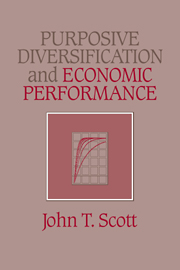Book contents
- Frontmatter
- Contents
- List of tables and figures
- Acknowledgements
- Introduction: An Overview
- Part I Static efficiency and the diversified firm
- Part II Firm and industry effects versus traditional models
- Part III Dynamic efficiency and the diversified firm
- 8 Theories linking diversification and R&D investment
- 9 Diversification of R&D and productivity
- 10 Multimarket rivalry and R&D intensity
- 11 Research diversity induced by rivalry
- Part IV Industrial policy
- Afterword: Perspectives through time and across countries
- Notes
- References
- Index
9 - Diversification of R&D and productivity
from Part III - Dynamic efficiency and the diversified firm
Published online by Cambridge University Press: 29 October 2009
- Frontmatter
- Contents
- List of tables and figures
- Acknowledgements
- Introduction: An Overview
- Part I Static efficiency and the diversified firm
- Part II Firm and industry effects versus traditional models
- Part III Dynamic efficiency and the diversified firm
- 8 Theories linking diversification and R&D investment
- 9 Diversification of R&D and productivity
- 10 Multimarket rivalry and R&D intensity
- 11 Research diversity induced by rivalry
- Part IV Industrial policy
- Afterword: Perspectives through time and across countries
- Notes
- References
- Index
Summary
This chapter explores how purposive diversification of R&D affects R&D behavior and productivity in U.S. manufacturing. The findings support the predictions developed in Chapter 8.
Purposive diversification
The chapter shows that R&D diversification in large U.S. manufacturing firms is purposive, exploiting complementarities of various research activities and forming groups of related industry categories. The purposively diversified firms behave differently from randomly diversified or undiversified firms. One aspect of the behavioral differences between purposively diversified firms and others is that the former allocate relatively more R&D funds to industry categories where the appropriation of the returns from R&D is easier and relatively fewer funds to those categories where returns are more difficult to appropriate. Finally, R&D expenditure and productivity are more closely linked at the group level than at the industry-category level, suggesting that spillovers of knowledge across industry categories are important. The chapter's findings provide a key explanation for the firm effects found in Part II, because firms in the same industry category typically engage in very different forms of purposive R&D diversification and some do not diversify at all.
In Section 9.2, I use my methodology to distinguish nonpurposive or random diversification from any purposive diversification into a set of related, or close, R&D activities. “Nonpurposive” diversification here is discerned as diversification dissimilar to patterns found in significant clusters of firms.
Information
- Type
- Chapter
- Information
- Purposive Diversification and Economic Performance , pp. 119 - 132Publisher: Cambridge University PressPrint publication year: 1993
